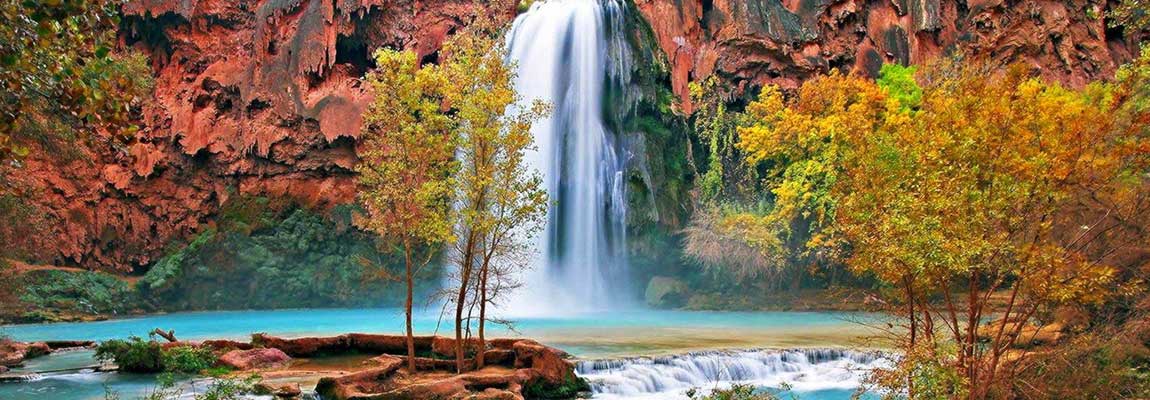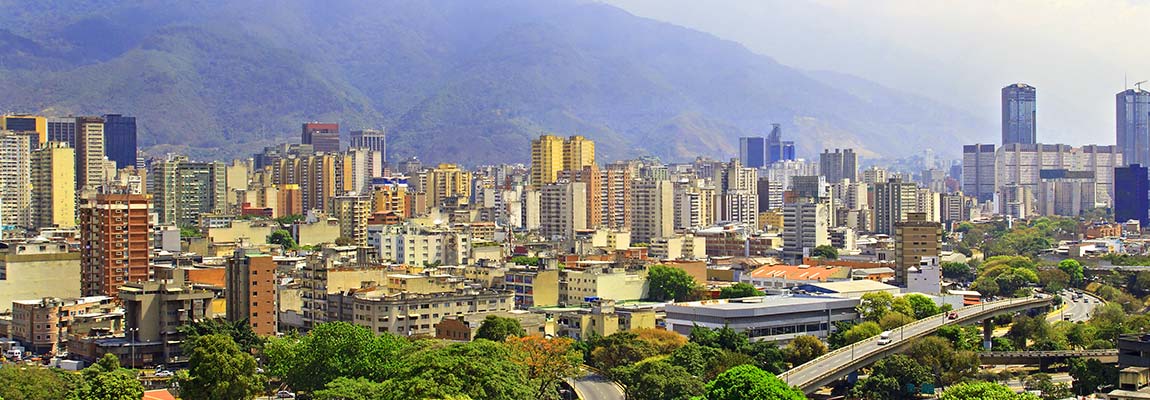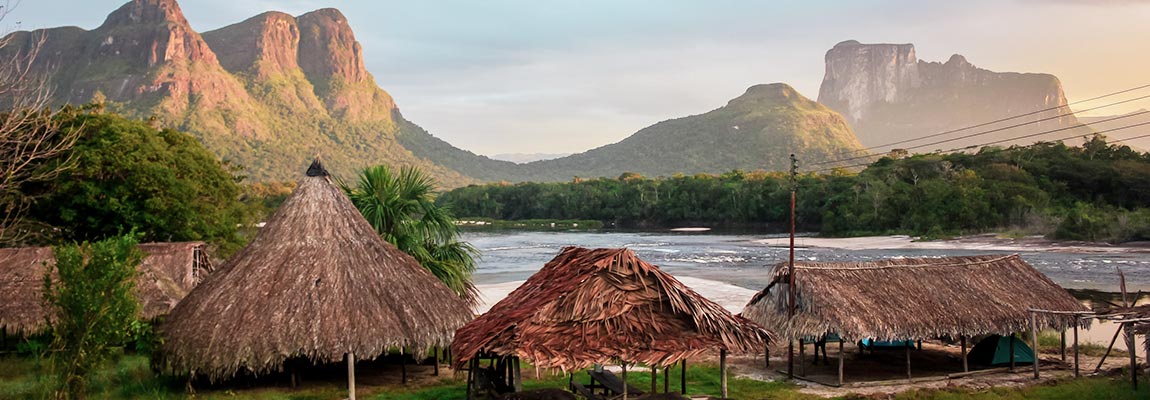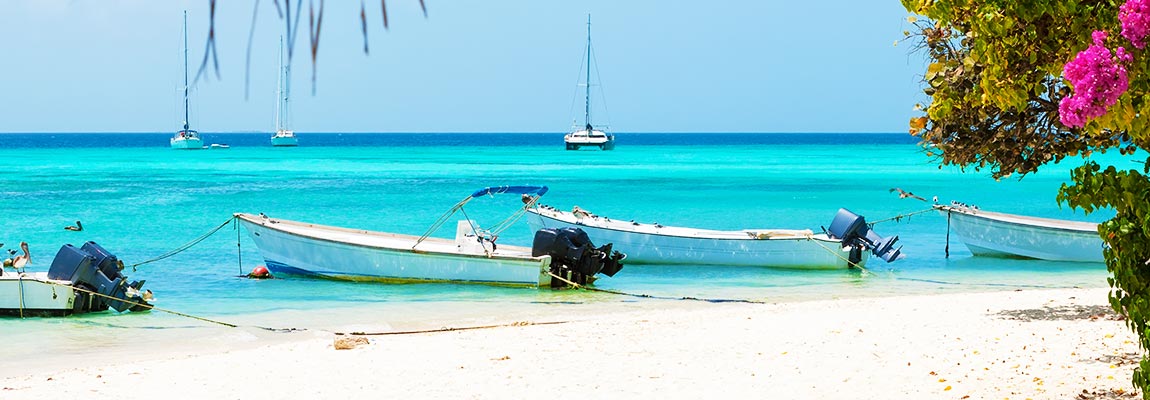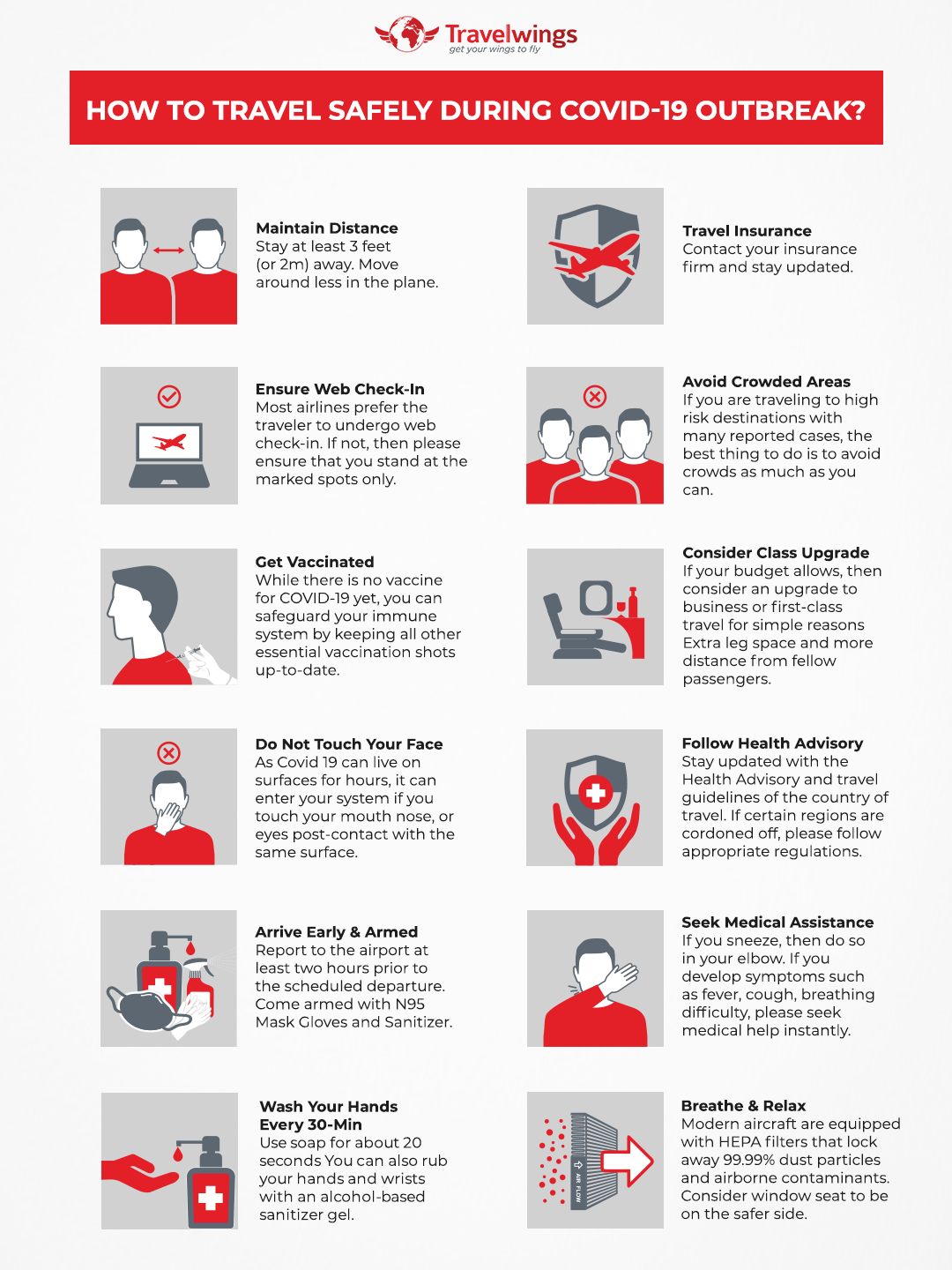Visit Venezuela, a South American nation that provides extraordinary diversity and natural
beauty. The country offers a collection of museums, historic monuments, delicious cuisine and
more. The Andean peaks, rich rainforests, beautiful Caribbean islands and exciting cities
welcome you. Venezuela tourism promises the beauty of the virgin rainforest of Amazonas, piranha
fishing in the Orinoco, sights of the soaring Andean peaks, stunning coastlines and more. Our
Venezuela travel guide gives insights into experiences, attractions and other information for an
amazing holiday.
USEFUL INFO ABOUT VENEZUELA
- Official Name: Bolivarian Republic of Venezuela
- Form of Government: Federal dominant-party presidential constitutional
republic
- Capital & Largest City: Caracas
- Population: 28887118 (2018 government estimate)
- Official Language: Spanish
- Languages Spoken: Spanish, Chinese, Portuguese, Italian, Wayuu
- Ethnicity: Mestizo 51.6%, White 43.6%, Black 3.6%, Indigenous 1.2%
- Currency: Bolivar Soberano
Map Referred: South America
- Area: 916445 sq km
- Land:8%
- Water:2%
- Lowest Point: Caribbean Sea (0 m)
- Highest Point: Pico Bolivar (5007 m)
- Coastline: 2800 km
Neighbouring places
- Brazil 2808 km
- Guyana 865 km
- The Caribbean Sea and the Atlantic Ocean
- Colombia 877 km
Famous For: Caribbean Coastline | Oil Reserves | Mountains | Catatumbo Lightning
| Natural Diversity | Largest Waterfall | South America’s Largest Lake | Budget Travel
Time Zone: GMT -4
Driving Side: Right
Airports in Venezuela: Caracas Simon Bolivar International Airport | La Chinita
International Airport | Arturo Michelena International Airport | Jacinto Lara International
Airport | Manuel Carlos Piar Guayana Airport and others
NETWORK / CONNECTIVITY
Venezuela has many internet providers but the main one is the state-owned CANTV.net. It offers
ADSL and Dial-up services. Broadband in Venezuela is provided also through cable, satellite,
Wi-Fi hotspots, EDGE and WiMAX. A good idea is to rent a pocket Wi-Fi to enjoy unlimited
internet in Venezuela through My Webspot. The portable Wi-Fi will ensure you enjoy your travel
while you stay connected. You can buy a Wraptel International SIM card for talk, text and mobile
data service. TravelSim provides prepaid international SIM cards for Venezuela so you save
international roaming fees.
In 1498, Christopher Columbus claimed Venezuela to be Spanish territory. The various regions were
left to develop separately from the capital Caracas and Spanish rule was from the outside. In the
18th century, there was widespread resistance led by Simon Bolivar. The attempt at unification made
him a national hero in Venezuela history. His dream was to create Gran Colombia that consists of
Venezuela, Ecuador and Colombia. However, due to infighting, Ecuador and Colombia collapsed and
Venezuela became a sovereign state led by Jose Paez.
Venezuela’s borders were not marked and periodic disputes began. In 1918, there was the
exploitation of the country's oilfields just as the cocoa and coffee wealth were largely exported.
The failing economy and widespread political corruption existed and the country was run by despotic
military leaders.
In the 1980s, social unrest made the government unstable and in 1992, the army units launched a
military coup. They won the 1998 elections and in 2000, further strengthened their power by de facto
means of constitutional changes. Land reforms sparked a strong opposition during the Chavez era.
After he died in 2013, his successor Nicolas Maduros term began. It was also a time of protests and
political suppression. The country’s economic, social and political scenario suffered. Medical
and food shortages prevailed and violent crime was common.
The country is located on the north coast of South America. It is bordered by the Caribbean Sea in
the north, Guyana and the Atlantic Ocean in the east. Colombia is a neighbour country in the west
and south-west and Brazil is to the south of Venezuela. The country has four distinct geographical
regions. They are the Venezuelan Highlands, the Maracaibo lowlands, the Guiana region and the
Orinoco plains.
The Venezuelan Highlands are mountains in the northeasternmost extension of the Andes Mountain chain.
Venezuela is located 8°C above the equator that makes the destination pleasant to travel
year-round. The Guyana region in the south includes the Amazon rainforest. The country is vulnerable
to earthquakes that include Caracas. The topographical features include attractions such as the
Orinoco River and the tabletop mountains known as tepuis. Angel Falls is the highest
waterfall in the world located here. The Andes Mountain ranges cross the northwest region and
include the peak, Pico Bolivar.
Art and Music
Venezuela culture and art are influenced by the Spanish conquest of the land. Paintings, fine arts,
music and dance are a fine blend of the pre-colonial and the colonial style. The music is a product
of intermingling Spanish, African and native music. Gaita is a traditional music style performed
mainly during festivals. Salsa is an important dance form and folk music is an important part of
Venezuela culture.
Food and Drink
Venezuelan cuisine is known for its flavour of 'Comida Criolla'. Beans, plantains, yucca, yams and
other vegetables and roots are commonly eaten. Beef is popularly cooked âa la parrilla' or on a
charcoal grill. Freshwater trout, fresh fish and seafood are also famously prepared in sancochos or
stews. Chinese, Spanish, Middle Eastern cuisines are also available, thanks to the number of
immigrants who live here.
Must-Try Venezuelan National Dishes
Perico Venezolano (scrambled eggs with onions, tomatoes and butter), Golfeados (cheesy and sticky
pastry), Hallaca (meat filling wrapped in corn flour dough), Casabe (a thin flatbread), Asado negro
(braised meat in red wine sauce), Pan de Jamon (bread stuffed with ham, olives and raisins)
Must-Try Venezuelan National Drinks
Batido (fruit juice), Chicha (boiled rice, milk and sugar), Cicada (milkshake made of coconut milk),
Frescolita (red soft drink), Merengada (fruit drink with milk, ice and sugar), Ponche Crema
(cream-based liquor), Venezuela Rum
Hospitality
Venezuelans are friendly people and generally relaxed about timekeeping. They toast with the word
'salud' in Spanish. It means good wishes to everyone, especially before sipping a drink. Verbal
greetings are common such as "Buenos Dias" which means Good Morning or "Buenas Noches" which means
Good Evening. They maintain eye contact while greeting and shake hands. Venezuelans also prefer to
embrace when greeting someone between the men and a kiss on the right cheek between men and women.
- Visit Venezuela for a budget-friendly holiday where one American dollar buys you a lot.
- Be among friendly locals who are warm and welcoming.
- For the taste of excellent rum and local cuisines.
- A backpacking experience and to discover spectacular scenery and tropical landscapes.
- For endless waterfalls, tabletop mountains in the Canaima National Park and the Gran Sabana.
- Explore the wetlands of Los Llanos for iguana, anteaters, anacondas, and more.
- Take incredible treks to Mount Roraima and in the Andes.
- To watch the natural beauty of the Catatumbo lightning with the highest frequency of bolts.
- The archipelago of Los Roques for unspoilt white sandy beaches and turquoise-blue waters.
- For a truly adventurous experience of the political propaganda the country witnessed.
- To meet native communities along the shores of Lake Maracaibo and in the Amazon region among
others.
Venezuela Weather | VEN Climate
The proximity of Venezuela to the equator makes the country enjoy welcoming Venezuelan weather all
year round. The best time to visit to have an outdoor adventure is in the dry season between
November to April. Rainfall is the least and humidity is lower overall during this time of the year.
The days are warm and sunny, cooling a little in the heights of the Andes around Merida. The rainy
season is avoidable. Go for the best hiking, sightseeing and other adventures in Venezuela in the
recommended dry months. Expect highs of 26°C and lows of 20°C with few showers in November
in Caracas.
Visit Venezuela with Family
- Explore the Canaima National Park for the 979m tall Angel Falls Waterfall, a massive table
topped mountain and more.
- Take the family to Mochima National Park for coastal mangroves, turtles, dolphins, cloud forests
and coral reefs.
- Laze on the sun-drenched beaches of Los Roques Archipelago and take in the turquoise ocean
views.
- Dive in the Morrocoy National Park beach waters along the coast or simply spend your day on the
white sandy beach.
Visit Venezuela as a Couple
- Take in the pleasures of Roraima, a tabletop mountain for its bizarre rock forms and splendid
waterfalls.
- Explore examples of marine life in the largest aquarium in Venezuela, Aquarium de Valencia.
- Spend time at the sacred shrine in Caracas, the National Pantheon, a popular attraction.
- Enjoy the rolling dunes in Medanos de Coro National Park.
Visit Venezuela with Friends
- Take a gondola lift ride to ascend El Avila Mountain at the El Avila National Park for
spectacular scenes.
- Take a trip to Margarita Island, a popular holiday destination of two peninsulas linked by the
mangroves of Laguna de la Restinga National Park.
- Sip on a chilled guarapita, a national rum punch and say cheers to celebrate the spirit of
freedom.
- Go snorkelling or scuba diving on the beach waters in Mochima National Park.
Visit Venezuela with Kids
- Take a gondola lift ride to ascend El Avila Mountain at the El Avila National Park for
spectacular scenes.
- Take a trip to Margarita Island, a popular holiday destination of two peninsulas linked by the
mangroves of Laguna de la Restinga National Park.
- Sip on a chilled guarapita, a national rum punch and say cheers to celebrate the spirit of
freedom.
- Go snorkelling or scuba diving on the beach waters in Mochima National Park.
What To Buy?
- Venezuelan Jewellery
- Carved Picture Frame
- Paperweight
- Mug
- Wood Carving
- Small Guitars
- Hammocks
- Cloth Bags
- Masks
- Gold Ornaments
- Venezuela Rum
Angel Falls
The most popular Venezuelan attraction is the Angel Falls on the Orinoco River. These spectacular
wonder falls have a drop of nearly a km. It is located in the Canaima National Park. Cool off by
taking a dip in the natural pools at the base below. The white sandy beaches around the lagoon make
the attraction unmissable.
Best Time to Visit: Dry season
Entry Price: Based on the tour
Los Roques National Park
This is one of the most beautiful places on earth with white sandy beaches, mangrove swamps and coral
reefs. The archipelago combines the beauty of the blue surrounding waters with the park. Have a fun
day sailing, diving, windsurfing, fishing, lobster catching and more.
Best Time to Visit: Dry season
Entry Price: USD (negligible)| BSF 155
Mount Roraima
Hike to the top of Mount Roraima, a fabulous flat tabletop mountain. The attraction is at an
elevation of 3000 metres and is a geological formation as old as two billion years. Watch rare
animals and birds, a place that was an inspiration for Sir Conan Doyle's, The Lost World.
Best Time to Visit: November to April
Entry Price: $50 upwards (trek per person with food and guide)
Los Llanos
This grassland region is also called The Plains and is located on the border of Colombia and
Venezuela. The ecoregion is ideal for wildlife and bird viewing, especially in the dry season.
Animals gather at water holes giving the nickname Serengeti of South America. Look out for jaguars,
caimans, capybaras and the unique Orinoco Crocodile.
Best Time to Visit: Dry season
Entry Price: Based on the tour
Medanos de Coro National Park
Travel to the Medanos de Coro National Park that is famous for its dunes. Some of them reach 40
metres and the dunes change shape with the high winds. Explore the area on a camel and take in the
beauty of yellow and orange dune scapes. Try the sandboarding adventures that the area offers.
Best Time to Visit: November to April
Entry Price: Based on the tour
The Andes
Worth visiting is the 400 km stretch of snow-capped Andes Mountains with Pick Bolivar as its highest
peak. Cascading waterfalls, green valleys, cloud forests, mountain villages and more make exploring
the mountains unforgettable. If trekking is your fun thing, then this attraction is a great
experience.
Best Time to Visit: Dry season
Entry Price: Based on the tour
Most Popular Regions and Cities to Visit in Venezuela
Caracas
The bustling metropolitan city is the capital of Venezuela. It has a wealth of culture, art and
history. It is geographically located at the base of the Avila Mountain range. Hiking expeditions up
the mountain range is a thrill for a splendid birds-eye view of the city. The city also offers
numerous museums, restaurants, historical sites and a zoo.
Visit For: National Pantheon, Parque Nacional El Avila, Parque del Este,
Contemporary Art Museum
Valencia
Valencia is surrounded by mountains and has several landmark attractions. It is west of Caracas and
is one of the largest cities. The east side of the city overlooks Lake Valencia. The city has
several public parks for sports and recreation. Everywhere there are tropical trees and greenery
with the backdrop of the lush Venezuelan mountains.
Visit For: The Central Market of Valencia, La Lonja de la Seda, L'Oceanografic,
Valencia Cathedral
Coro
This beautiful town is a UNESCO World Heritage site and was once the capital of Venezuela. The
well-preserved architecture since the colonial days makes the town attractive. Tour the brightly
coloured buildings, churches, mission buildings and more. Dunes can be easily seen as you drive out
of Coro that has formed north of the city.
Visit For: Cathedral Basilica of St. Ann, Museo de Arte de Coro, Plaza San Clemente
Maracaibo
Maracaibo is known as the economic centre of the west of Venezuela. The city is nicknamed "The land
of the beloved sun". It is the capital of Zulia state and is the second-largest city in the country.
A popular natural phenomenon is the Catatumbo lightning that occurs over the Catatumbo River and
descends into Lake Maracaibo.
Visit For: Vereda del Lago, Aguamania, Laguna de Sinamaica,Puente General Rafael
Urdaneta
Ciudad Guayana
The port city is located in the Caroni and Orinoco Rivers. The city is the gateway to Gran Sabana and
Orinoco Delta. Guayana comprises two towns, San Felix and Puerto Ordaz. Between the towns are famous
attractions of the La Llovizna Waterfalls and Cachmay Parks.
Visit For: La Llovizna Park, Llovizna Falls, Parque Cachamay, Loefling Park
Mosque
If you have time, here are other popular places to visit in Venezeula,
- Maracay
- Merida
- Cumana
- Puerto Cabello
- Amazonas
- Barinas
- Bolivar
- Cojedes
Festival of Saint Peter and Saint Paul
The festival is a tribute to the apostles of Christianity, Saint Peter and Saint Paul. The locals
celebrate with live music, dance, bonfires lit on the road and more. Locals dress in traditional
clothes and a variety of street food is also available.
Location : Venezuela
Date : June - July
El Callao Carnival
The four-day festival is celebrated in the small town of El Callao. This is a mining town full of
immigrants and mixed cultures. The parade is led by dancing madamas dressed colourfully with African
headdresses. There are the medio-pintos whose bodies are painted in black.
Location : El Callao
Date : February
San Benito Festival
This annual event is a two-day festival in honour of San Benito de Palermo. He was the black saint in
Venezuela. Locals dress as San Benito and paint their faces black. There are parades with spirited
dancing and grand costume displays.
Location : Venezuela
Date : December
Carupano Carnival
This much-anticipated festival is a four-day cultural event. Families come together to celebrate a
musical extravaganza. The festival is similar to Mardi Gras where locals wear creative costumes and
robes. Streets are filled with parties and floats.
Location : Venezuela
Date : February - March
Feria del Sol
The festival is also called 'Fair of the Sun' and is celebrated in February. The town of Merida
becomes lively and vibrant. Locals dress up in brightly coloured costumes and wear beautiful masks.
There is plenty of dancing into the late night.
Location : Merida
Date : February
Other festivals/events celebrated in Venezuela are:
- La Chinita Fair
- El Hatillo Music Festival
- Corpus Christi Devil Dancing, San Franciso de Yare
- The Festival of San Juan
- Virgin of Coromoto Festival
Passports
All travellers must have a valid passport to apply for a Venezuelan visa. The passport needs to be
valid for a minimum of six months upon entry. The passport must have at least three blank pages for
visa stamping.
Venezuela Visa-on-arrival/eVisa/Visa-free entry
Visitors must obtain a Venezuela visa to travel into the country from one of the Visa Diplomatic
Missions. Citizens of the following countries are allowed visa-free entry for up to 90 days for
tourism purposes;
- EU
- Andorra
- Antigua and Barbuda
- Argentina
- Australia
- Barbados
- Belarus
- Bellies
- Bolivia
- Brazil
- Colombia
- Costa Rica
- Dominica
- Ethiopia
- Grenada
- Hong Kong
- Iceland
- Iran
- Jamaica
- Japan
- Liechtenstein
- Malaysia
- Mexico
- Monaco
- Nicaragua
- New Zealand
- Norway
- Palestine
- Paraguay
- Qatar
- Russia
- Saint Kitts and Nevis
- Saint Lucia
- Saint Vincent and the Grenadines
- San Marino
- South Africa
- South Korea
- Switzerland
- Trinidad and Tobago
- United Kingdom
- Uruguay
There are no provisions for an online e visa. Visitors have to apply in advance for a visa at the
Venezuelan Embassy if they are not from a country whose citizens are allowed visa-free entry.
Types of Visa and Validity
The tourist visa and business visas are single entry and multiple entry visas. It allows a stay
period of 90 days and the validity of the visa is given by the Embassy. The processing time is
about 10 to 15 days and the processing fee starts from $53.70 upwards.
The embassy is very strict with the document requirements and photographs. A Yellow Fever
Certificate is also mandatory for the visa application procedure to be completed.
Air
Domestic airlines operate that connect almost every important town in the country. SBA Airlines,
Aeropostal, Acerca Airlines and Avior are among the popular domestic airlines operating in the
country. The flight options may be the best to travel around Venezuela but not the cheapest. Flights
to far-flung places like the Angel Falls in Canaima and the Amazon region are expensive. Book a
flight in advance during the summers.
Taxi
Caracas, the capital, has plenty of taxi services without meters. Fares are agreed upon before the
ride. Official taxis are with a yellow license plate and are safer. The shared taxis are called âpor
puestoâ and are very much like minibuses. There are also the old US cars called busetas or carritos
that follow set routes.
Coach
This is the best way to get around with fares being cheap and rides comfortable. However, look for
luxury coaches with bed seats, air-conditioning and TV/DVD players. You get bus terminals in Caracas
that ply to different parts of the country. Luxury coaches have their terminals such as Aeroexpresos
Ejecutivos. The metro in Caracas connects to long-distance bus stations.
Light Rail Train
The Caracas subway and a suburban light-rail train operate. No passenger trains are operating.
Ferry
There are ferry services that link Isla de Margarita to the mainland at Puerto La Cruz.
Via Air Route
There are plenty of carriers such as Air France, Iberia and Air Europa that operate direct flights
from mainland Europe. LASER Airlines and SBA Airlines offer a direct flight from Miami. Caracas
Simon Bolivar International Airport is the main airport in Venezuela that services international
flights into the country.
Via Rail
There are no international rail links as of now to neighbouring countries. There is a short line
between Caracas and the town of Cua that is the only line operating.
Via Road
Road links are available between Colombia and Brazil and have international bus services. The average
travel time is 12 hours from the Colombia border to Caracas. Travelling by car is a quicker way to
reach.
Via Sea
Many major cruises lines dock at the port of El Guamache. There are Caribbean cruises that also
include the Los Roques archipelago and La Guaira in their network.
Travel Tips
- Venezuela is an unstable country due to political and economic instability. Think twice before
you travel here.
- Violent crime is widespread and Caracas is the most murderous city in the world by death toll.
- The official language is Spanish, so it is a good idea to carry a travel guide.
- Carry small denominations as many vendors do not accept large bills and run out of change.
- Travel to Venezuela is usually cheap and it is good to remember that the official rate of
exchange is higher than the tourist rate.
- It is best to carry your passport at all times.
- Never use your credit card for payment and exchange currency with someone you trust.
- Be watchful of climate changes from the jungle to the desert and carry adequate clothes.
- Read about practical information before you travel.
- Avoid travelling here in the wet months which is from May to October.
Safety Tips
- Keep your valuables and belongings safe.
- Roads are unsafe as the locals drive very rashly. Cross the road with caution.
- Look out for wacky races that Venezuelans indulge in and take extra caution as drivers are not
going to stop for safety.
- Stay safe while walking and avoid going out in the dark alone.
- Dress like the locals to avoid drawing attention towards you.
- Walk with confidence and do not carry a map or indicate in any way that you are unsure of
yourself.
Health Tips
- Yellow Fever and dengue are risks while travelling in Venezuela. Get your vaccinations in
advance.
- Talk to your GP about malaria prevention and carry anti-malaria medications.
- Invest in good travel insurance to use during an emergency.
- Carry a medical and first aid kit as an essential add-on as medical supplies are not easily
available.
- Several vaccinations are important to take as recommended by CDC and WHO such as Hepatitis A,
Hepatitis B, Typhoid, Cholera, Covid 19, Yellow Fever, Rabies, Meningitis, Polio, Measles,
Mumps and Rubella, Tdap, Chicken Pox, Shingles, Pneumonia and Influenza.
- Always drink boiled water and be wary of the hygiene aspects of the local food.
What to Pack?
- Travel Documents
- Medical Kit
- Insect Repellent
- Walking Shoes, Flip Flops
- Mountain Gear
- First Aid Kit
- Swim Suit
- Mask
- Weather favourable clothes
- International Driver’s License
- Camera
- English to Spanish Dictionary
- Sunscreen
Dress Code & Etiquette
- Western wear with European style influences is worn by Venezuelans as daily wear. However,
traditional clothes are worn on special occasions.
- Beauty and fashion are very important to Venezuelans and traditional costumes are very pretty.
- Venezuelan men wear liqui liqui as a folk costume and females wear long flowing skirts, blouses
with off shoulders, a lot of flowers and jewellery.
- Handshakes are the normal way of introduction while embraces are between friends.
- Punctuality is practised in a business forum.
- Goodbyes are said to each individual while leaving.
- ‘Buenos dias’ means good morning, ‘Hasta luego’ means goodbye,
‘Gracias’ means ‘thank you’ which are some of the common Spanish phrases
used.
- Always begin eating only after all diners are seated and the host invites you to start the meal.
- Continental table manners are followed.
- Pointing the index finger is considered rude and eye contact is maintained while talking.
Colombia (877 km)
Colombia is noted for its natural beauty, tropical rainforests, mountains and beaches. The country in
the north of the South American continent is worth visiting for its biodiversity, heritage and
history.
Guyana (865 km)
Admire the Kaieteur Falls, beautiful rainforests, the world's largest lily, wildlife experiences and
more. Guyana is home to unspoilt nature, plenty of wildlife including the big cats. Guyana is a
thrilling destination to learn about conservation efforts and incredible wildlife.
Distance Between Places of Importance in and around Venezuela
Brazil - 2808 km
- Venezuela is home to the highest waterfall in the world, the Angel Falls.
- It is in this country you find the world's largest rodent, the capybara.
- Caracas is visited by Guacamayas, colourful macaws every evening.
- The high table mountains have no peaks.
- Venezuela's biggest tepuis are the Auyantepui with a surface of 700 square km.
- Locals travel to the church early morning in roller skates during the Christmas season.
- Coro, the port city is listed as a UNESCO World Heritage Site.
CALLING CODE: +58
Emergency: 171
Police: 171
Medical: 171
Venezuela currency is the Venezuelan Bolivar and the currency code is VEB. The bolivar fuerte was the
currency and after devaluation, it was replaced by bolivar soberano in 2018. It is broken into 100
centimos and the Venezuela currency symbol is Bs. The currency exchange rate for some of the most
popular currencies are,
Symbol: Bs
Code: VEB
1 VEB =0 .000023 INR (Venezuela currency to INR)
1 VEB = 0.00 USD (Venezuela currency to USD)
1 VEB =0.0000011 AED (Venezuela currency to AED)
1 VEB = 0.000049 PKR (Venezuela currency to PKR)
Venezuela currency banknote denomination: 2, 5, 10, 20, 50, 100, 200, 500 bolivar (rarely used) |
1.000, 2.000, 5.000, 10000, 20000, 50000 (frequently used)
Venezuela currency coin denomination: 10, 20, 50, 100, 500, 1000 bolivares
Please note that Travelers Cheques are NOT accepted in most places. The ROE is subject to change
as per currency fluctuations.
- Customized and Safe Holidays: Just tell us all about your dream holiday and we
would turn it into a reality. Your safety and comfort are our priority. Reserve the best of both
worlds with us.
- Global Presence: We are Global. Travel anywhere and everywhere. Book flight
tickets and hotels instantly. There are no boundaries and no limitations with us.
- Special Packages: Select from a range of budget-friendly to luxury vacation
packages of your choice. We have specialized travel and tour packages for couples, families, and
solo travellers.
- 24X7 Customer Support: Need Help? Talk to our agent on the go. We are at your
service 24X7.


